A Learning Environment to Promote Awareness of the Experiential Learning Processes with Reflective Writing Support
Abstract
1. Introduction
2. Background
2.1. Experiential Learning
2.2. Reflective Writing and Metacognition
2.3. Reflective Writing as a Tool to Support Reflection
3. EL Framework
- Pre-phase: understanding the EL concepts;
- Experiencing phase: understanding how to apply those EL concepts in reflective writing through a learning environment;
- Post-phase: reflecting on the self-monitoring of metacognitive thinking.
3.1. Pre-Phase
3.1.1. An Orientation Program and Guideline for Learners
3.1.2. The Metacognitive Skills Scale: BEFORE (MSS-PRE)
3.2. Experiencing Phase
3.2.1. Verbalization Support with Sentence Openers
3.2.2. Visualization of Learner’s Thinking Behavior
3.2.3. Recursive Thinking Reminder
3.3. Post-Phase
3.3.1. The MSS:AFTER (MSS-POST)
3.3.2. Mini-Exam
3.3.3. Reflection Sheet
4. Learning Environment Design
- In the CE part, the question, “what have you experienced?” guides learners to search for their experience.
- In the RO part, the question, “what are your successful and failed experiences” allows learners to reflect on all their experiences, as many learners only focus on successful experiences and do not realize the shortcomings in their EL.
- In the AC part, the question, “what have you learned from the experience” guides learners to think of the abstract concept that represents what they have learned.
- In the AE part, the question, “what will you use for learning next” guides learners to consider how to apply what they have learned in the future.
4.1. Verbalization Support Function with Sentence Openers
- First, Kolb [1] provides the core EL concepts, and this serves as our primary source. This book describes EL-related concepts, such as gaining and transforming experience and creating knowledge by connecting two processes (e.g., divergent, assimilating, convergent, and accommodating knowledge).
- Second, the MSS [33] has 30 questions on the metacognitive thinking required for EL. Hence, the MSS can guide the design of the sentence openers for the CE and AC concepts.
- Third, the concept of self-regulated learning by Zimmerman et al. [21,38] contains related knowledge on metacognitive thinking, such as forethought, self-reflection, self-control, and observational skills. Hence, self-regulated learning satisfies the requirement for sources as it is shown to reinforce the development of EL skills mutually [39].
- Fourth, Moon [5] describes what is not reflective writing and what kind of questions facilitate and prompt more profound reflection.
- Concrete Experience (CE): The sentence opener promotes thinking by writing the concrete selection, thereby reminding the learners of a CE based on apprehension, which relies on the immediate and tangible qualities of the experience.
- Reflective Observation (RO): The sentence opener promotes thinking by writing the observation of CE based on intention, thereby reflecting internally on the various characteristics of their experiences and ideas.
- Abstract Conceptualization (AC): The sentence opener promotes thinking by writing the conceptual interpretation of the symbolic representation of experience based on comprehension, an individual’s reliance on conceptual interpretation, and symbolic representation.
- Active Experimentation (AE): The sentence opener promotes thinking by writing the plan as a guide to creating new experience based on extension, thereby testing the ideas and experiences in the real world.
| Concept | Example of Sentence Opener | Source |
|---|---|---|
| Concrete Experience (CE) |
| (1) [1], (2) [33] |
| Reflective Observation (RO) |
| (1) [1], (2) [33], (3) [40], (4) [5] |
| Abstract Conceptualization (AC) |
| (1) [1], (2) [33] |
| Active Experimentation (AE) |
| (1) [1], (2) [33], (3) [40] |
- Concrete Experience (CE) to Reflective Observation (RO) (Divergent Thinking): grasps experience and transforms.
- Reflective Observation (RO) to Abstract Conceptualization (AC) (Assimilative Thinking): experience is absorbed through comprehension and transformed through intention.
- Abstract Conceptualization (AC) to Active Experimentation (AE) (Convergent Thinking): grasps via comprehension and transforms via extension.
- Active Experimentation (AE) to Concrete Experience (CE) (Accommodative Thinking): experience is grasped via apprehension and transformed via extension.
4.2. Visualization of Learners’ Thinking Behavior Function
- Clicking to expand the sentence opener at the root node at time t1;
- Browsing through the options for sentence openers at time t2;
- Writing text after the selection of the sentence opener at time t3.
- Changing sentence openers at time t4;
- Selecting the sentence-opener category (CE to RO) at time t5;
- Finally selecting the sentence-opener choice (# SO-2-3-1) at time t6;
- Deleting the sentence-opener choice (# SO-1-1-6) at time t7.
- Object: The learning object in the user interface with which learners interact, such as the sub-category of sentence opener in the CE and RO category, the CE’s text field, the sentence openers list, and the recursive list.
- Action: An action value that is performed by learners. For example, they select or browse the sentence-opener options by typing, opening the list, and deleting.
- Key: The value that the learners input, such as the selected sentence opener, category of the sentence opener, choice of the previous week’s experience, and use of text.
- Time: The period in which the learners’ events happened.
- 4 (Strongest Cue) is when the learner selects a sentence opener for reflective writing for at least two consecutive weeks without trial and error.
- 3 (Strong Cue) is when the learner selects a sentence opener for reflective writing without trial and error for the first time.
- 2 (Neutral) is when the learner selects sentence openers for reflective writing with trial and error.
- 1 (Light Cue) is when the learner browses through sentence-opener options and does not use them in reflective writing.
- 0 (No Cue) is when the learner does not use sentence openers.
- 4 (Strongest Cue) is when the learner selects a sentence opener in CE and chooses one of the previous experiences in a recursive list for at least two consecutive weeks without trial and error.
- 3 (Strong Cue) is when the learner selects a sentence opener in CE and chooses one of the previous experiences in a recursive list for the first time.
- 2 (Neutral) is when the learner chooses one of the previous experiences in a recursive list with trial and error.
- 1 (Light Cue) is when the learner chooses one of the previous experiences in a recursive list with trial and error.
- 0 (No Cue) is when the learner does not use a recursive list.
4.3. Recursive-Thinking Reminder Function
5. Exemplifying EL in the Learning Environment
5.1. Case Study #1: The Learner That Became Aware of EL Processes (CE, RO, AC, and AE)
5.1.1. Interpretation of Learners in Case Study # 1
5.1.2. Discussion on the Learner in Case Study #1
5.2. Case Study #2: The Learner That Became Partially Aware of EL Processes (CE and RO)
5.2.1. Interpretation of the Learner in Case Study #2
5.2.2. Discussion on the Learner in Case Study #2
5.3. Discussion of the Phenomena Observed in the Learning Environment
6. Conclusions
Author Contributions
Funding
Institutional Review Board Statement
Informed Consent Statement
Data Availability Statement
Acknowledgments
Conflicts of Interest
References
- Kolb, D.A. Experiential Learning: Experience as the Source of Learning and Development, 2nd ed.; Pearson FT Press: Upper Saddle River, NJ, USA, 2015. [Google Scholar]
- Rodgers, C. Defining Reflection: Another Look at John Dewey and Reflective Thinking. Teach. Coll. Rec. 1988, 104, 416. [Google Scholar]
- Dewey, J. How Do We Think: A Restatement of the Relation of Reflective Thinking to the Educative Process; D.C. HEALTH & CO.: Boston, MA, USA, 1933. [Google Scholar]
- Levin, T.; Wagner, T. In Their Own Words: Understanding Student Conceptions of Writing through Their Spontaneous Metaphors in the Science Classroom. Instr. Sci. 2006, 34, 227–278. [Google Scholar] [CrossRef]
- Moon, J.A. A Handbook of Reflective and Experiential Learning: Theory and Practice, 1st ed.; Routledge: London, UK, 2004. [Google Scholar]
- YuekMing, H.; Manaf, L.A. Assessing Learning Outcomes through Students’ Reflective Thinking. Procedia Soc. Behav. Sci. 2014, 152, 973–977. [Google Scholar] [CrossRef]
- King, T. Development of Student Skills in Reflective Writing. In Spheres of Influence: Ventures and Visions in Educational Development. Proceedings of the 4th World Conference of the International Consortium for Educational Development; The University of Western Australia: Perth, Australia, 2002. [Google Scholar]
- Kohonen, V. Learning to Learn through Reflection–an Experiential Learning Perspective. Prep. Teachnol. Use Eur. Lang. Portf. –Argum. Mater. Resour. 2007, 24, 1–10. [Google Scholar]
- Aziz, A.; Mahboob, U.; Saleem, T. Benefits of Reflective Writing in Health Care through the Vivid Lens of House Officers. MedEdPublish 2020, 9, 60. [Google Scholar] [CrossRef]
- Sharif, A.M.; Zainuddin, S.Z. Students’ Perceptions of Their Reflective Essay Writing Experience and Teacher Feedback Comments. Indones. J. Appl. Linguist. 2017, 6, 204–212. [Google Scholar] [CrossRef]
- Chretien, K.; Goldman, E.; Faselis, C. The Reflective Writing Class Blog: Using Technology to Promote Reflection and Professional Development. J. Gen. Intern. Med. 2008, 23, 2066–2070. [Google Scholar] [CrossRef]
- Mahmoud, A.; Nagy, Z.K. Applying Kolb’s Experiential Learning Cycle for Laboratory Education. J. Eng. Educ. 2009, 98, 283–294. [Google Scholar] [CrossRef]
- Roberts, J. From the Editor: The Possibilities and Limitations of Experiential Learning Research in Higher Education. J. Exp. Educ. 2018, 41, 3–7. [Google Scholar] [CrossRef]
- Mc Pherson-Geyser, G.; de Villiers, R.; Kavai, P. The Use of Experiential Learning as a Teaching Strategy in Life Sciences. Int. J. Instr. 2020, 13, 877–894. [Google Scholar] [CrossRef]
- Morris, T.H. Experiential Learning–a Systematic Review and Revision of Kolb’s Model. Interact. Learn. Environ. 2020, 28, 1064–1077. [Google Scholar] [CrossRef]
- Tanaka, K.; Ikeda, M.; Mizushima, K.; Nakabayashi, K. Learning How to Learn with Knowledge Building Process through Experiences in New Employee Training: A Case Study on Learner-Mentor Interaction Model. Int. J. Knowl. Web Intell. 2017, 6, 20–34. [Google Scholar] [CrossRef]
- Kingkaew, C.; Supnithi, T.; Theeramunkong, T.; Morita, K.; Tanaka, K.; Ikeda, M. A Learning Model To Improve Outcome On Experiential Learning In A Multi-Phase Internship: A Case Study Of The Internship Program Of A Thai University. In Proceedings of the 8th International Congress on Advanced Applied Informatics, Toyama, Japan, 7–11 July 2019. [Google Scholar] [CrossRef]
- Dewey, J. Experience—The Means and Goal of Education. In Experience and Education; Touchstone: New York, NY, USA, 1938; pp. 89–91. [Google Scholar]
- Gibbs, G. Learning by Doing: A Guide to Teaching and Learning Methods; Geography Discipline Network: Cheltenham, UK, 2001. [Google Scholar]
- Rolfe, G.; Freshwater, D.; Jasper, M. Critical Reflection for Nursing and the Helping Professions a User’s Guide; Palgrave MacMillan: London, UK, 2001. [Google Scholar]
- Jasper, M.; Rosser, M. Reflection and Reflective Practice. In Professional Development, Reflection and Decision-Making in Nursing and Healthcare; Wiley: New York, NY, USA, 2013; pp. 41–82. [Google Scholar]
- Kolb, A.Y.; Kolb, D.A. The Learning Way: Meta-Cognitive Aspects of Experiential Learning. Simul. Gaming. 2009, 40, 297–327. [Google Scholar] [CrossRef]
- Flavell, J.H. Metacognition and Cognitive Monitoring: A New Area of Cognitive-Developmental Inquiry. Am. Psychol. 1979, 34, 906–911. [Google Scholar] [CrossRef]
- Tanaka, K.; Dam, H.C.; Kobayashi, S.; Hashimoto, T.; Ikeda, M. Learning How to Learn through Experiential Learning Promoting Metacognitive Skills to Improve Knowledge Co-Creation Ability. Procedia Comput. Sci. 2016, 99, 146–156. [Google Scholar] [CrossRef]
- Zarestky, J.; Bigler, M.; Brazile, M.; Lopes, T.; Bangerth, W. Reflective Writing Supports Metacognition and Self-Regulation in Graduate Computational Science and Engineering. Comput. Educ. Open 2022, 3, 100085. [Google Scholar] [CrossRef]
- Alt, D.; Raichel, N.; Naamati-Schneider, L. Higher Education Students’ Reflective Journal Writing and Lifelong Learning Skills: Insights From an Exploratory Sequential Study. Front. Psychol. 2022, 12, 1–17. [Google Scholar] [CrossRef]
- Franco, R.S.; dos Franco, C.A.G.; Severo, M.; Ferreira, M.A.; Karnieli-Miller, O. Reflective Writing in the Teaching of Communication Skills for Medical Students—A Systematic Review. Patient Educ. Couns. 2022, 105, 1842–1851. [Google Scholar] [CrossRef]
- Dressler, J.A.; Ryder, B.A.; Connolly, M.; Blais, M.D.; Miner, T.J.; Harrington, D.T. “Tweet”-Format Writing Is an Effective Tool for Medical Student Reflection. J. Surg. Educ. 2018, 75, 1206–1210. [Google Scholar] [CrossRef]
- ChanLin, L.-J.; Hung, W.-H. Evaluation of An Online Internship Journal System for Interns. Procedia Soc. Behav. Sci. 2015, 191, 1024–1027. [Google Scholar] [CrossRef]
- Moussa-Inaty, J. Reflective Writing through the Use of Guiding Questions. Int. J. Teachnol. Learn. High. Educ. 2015, 27, 104–113. [Google Scholar]
- Pamungkas, S.F.; Widiastuti, I.; Suharno, S. 21st Century Learning: Experiential Learning to Enhance Critical Thinking in Vocational Education. Univers. J. Educ. Res. 2020, 8, 1345–1355. [Google Scholar] [CrossRef]
- Kolb, D.A.; Yeganeh, B. Deliberate Experiential Learning. In Contemporary Organization Behavior in Action; Pearson Education: Upper Saddle River, NJ, USA, 2012; pp. 1–12. [Google Scholar]
- Altindağ, M.; Senemoglu, N. Metacognitive Skills Scale. H. U. J. Educ. 2013, 28, 15–26. [Google Scholar]
- Graesser, A.C.; Conley, M.W.; Olney, A. Intelligent Tutoring Systems. Intell. Tutoring Syst. E-Learning Environ. 2010, 2579, 1–26. [Google Scholar] [CrossRef]
- Bland, A.J.; Topping, A.; Tobbell, J. Time to Unravel the Conceptual Confusion of Authenticity and Fidelity and Their Contribution to Learning within Simulation-Based Nurse Education. A Discussion Paper. Nurse Educ. Today 2014, 34, 1112–1118. [Google Scholar] [CrossRef]
- Dieckmann, P.; Gaba, D.; Rall, M. Deepening the Theoretical Foundations of Patient Simulation as Social Practice. Simul. Healthc. 2007, 2, 183–193. [Google Scholar] [CrossRef]
- Trouche, L. Managing the Complexity of Human/Machine Interactions in Computerized Learning Environments: Guiding Students’ Command Process through Instrumental Orchestrations. Int. J. Comput. Math. Learn. 2004, 9, 285. [Google Scholar] [CrossRef]
- Zimmerman, B.J. Becoming a Self-Regulated Learner: An Overview. Theory Pract. 2002, 41, 64–70. [Google Scholar] [CrossRef]
- Alvi, E.; Gillies, R.M. Promoting self-regulated learning through experiential learning in the early years of school: A qualitative case study. Eur. J. Teach. Educ. 2020, 44, 135–157. [Google Scholar] [CrossRef]
- Duangnamol, T.; Supnithi, T.; Srijuntongsiri, G.; Ikeda, M. Computer-Supported Meta-reflective Learning Model via mathematical word problem learning for training metacognition. Res. Pract. Technol. Enhanc. Learn. 2018, 13, 1–29. [Google Scholar] [CrossRef]
- Woolf, B.P. Student Modeling. In Advances in Intelligent Tutoring Systems; Nkambou, R., Bourdeau, J., Mizoguchi, R., Eds.; Springer: Berlin, Heidelberg, 2010; Volume 308, pp. 267–279. [Google Scholar] [CrossRef]
- Ismail, M.N.; Ngah, N.A.; Umar, I.N. Instructional Strategy in the Teaching of Computer Programming: A Need Assessment Analyses. Turkish Online J. Educ. Technol. 2010, 9, 125–131. [Google Scholar]
- Gjerde, K.P.; Padgett, M.Y.; Skinner, D. The Impact of Process vs. Outcome Feedback on Student Performance and Perceptions. Int. J. Acad. Bus. World 2017, 13, 73–82. [Google Scholar]
- Dunning, D. The Dunning-Kruger Effect. On Being Ignorant of One’s Own Ignorance, 1st ed.; Elsevier: Amsterdam, The Netherlands, 2011; Volume 44. [Google Scholar] [CrossRef]
- Bull, S.; Kay, J. Open Learner Models BT—Advances in Intelligent Tutoring Systems; Nkambou, R., Bourdeau, J., Mizoguchi, R., Eds.; Springer: Berlin, Heidelberg, 2010; pp. 301–322. [Google Scholar] [CrossRef]
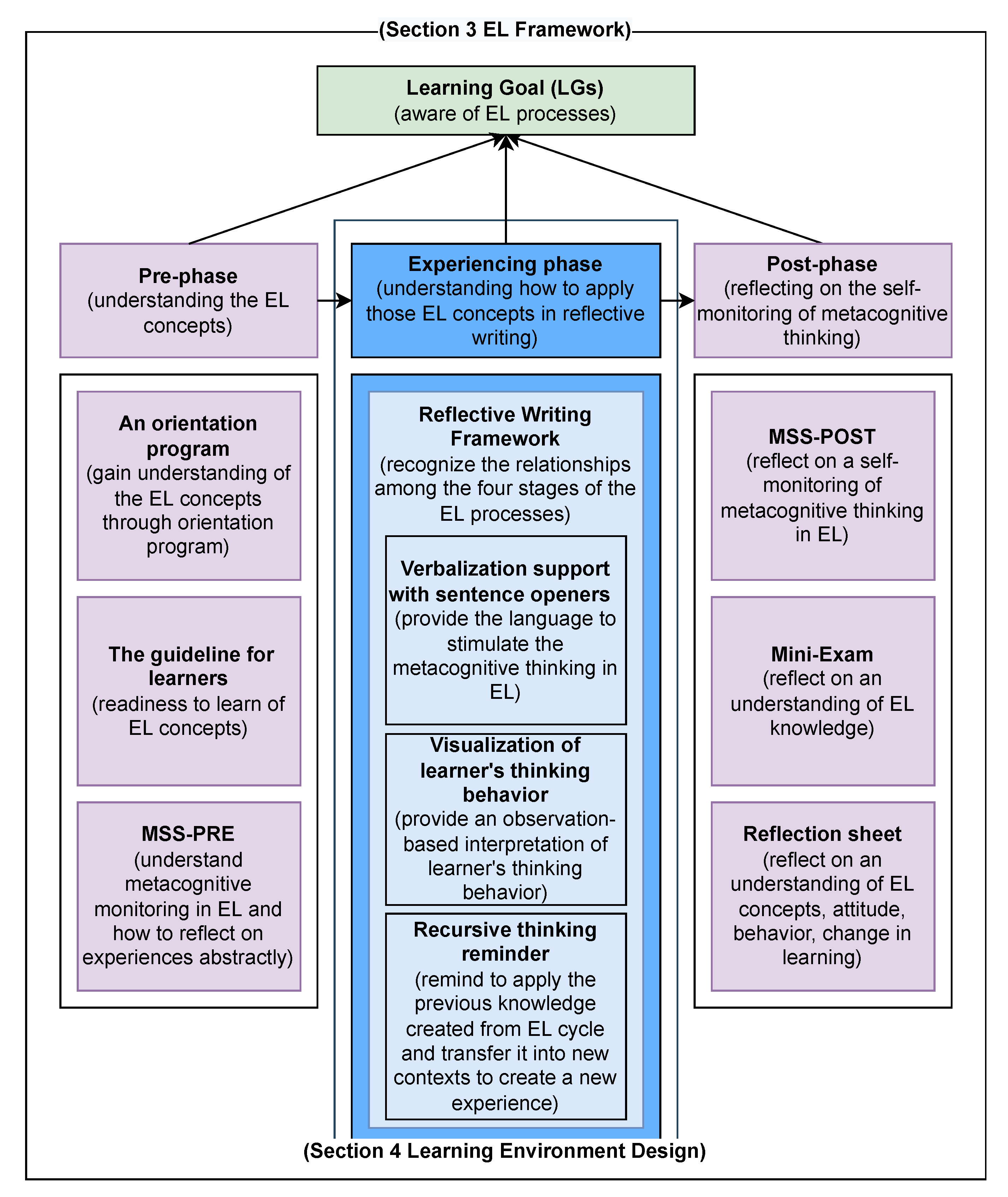
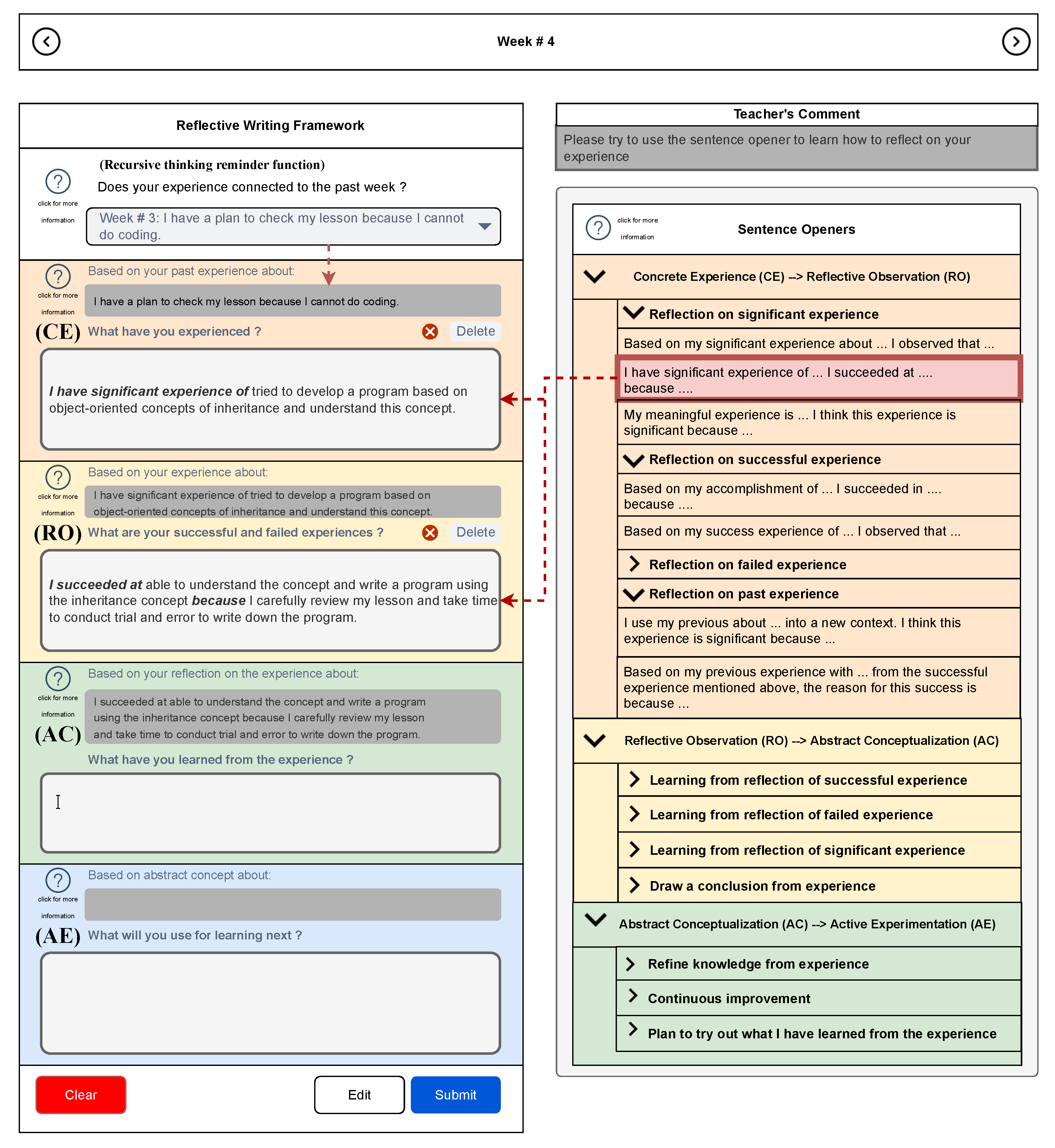
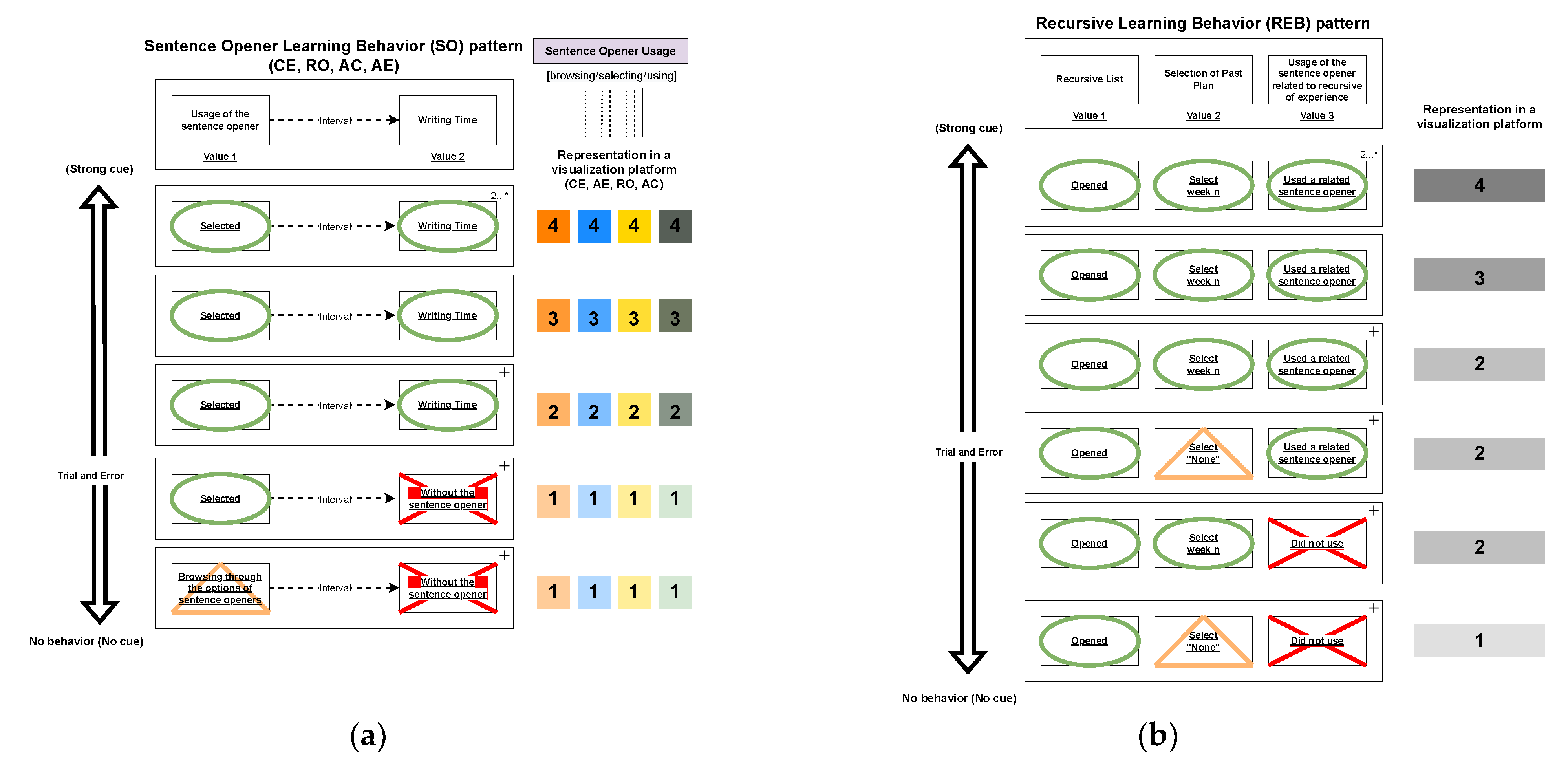
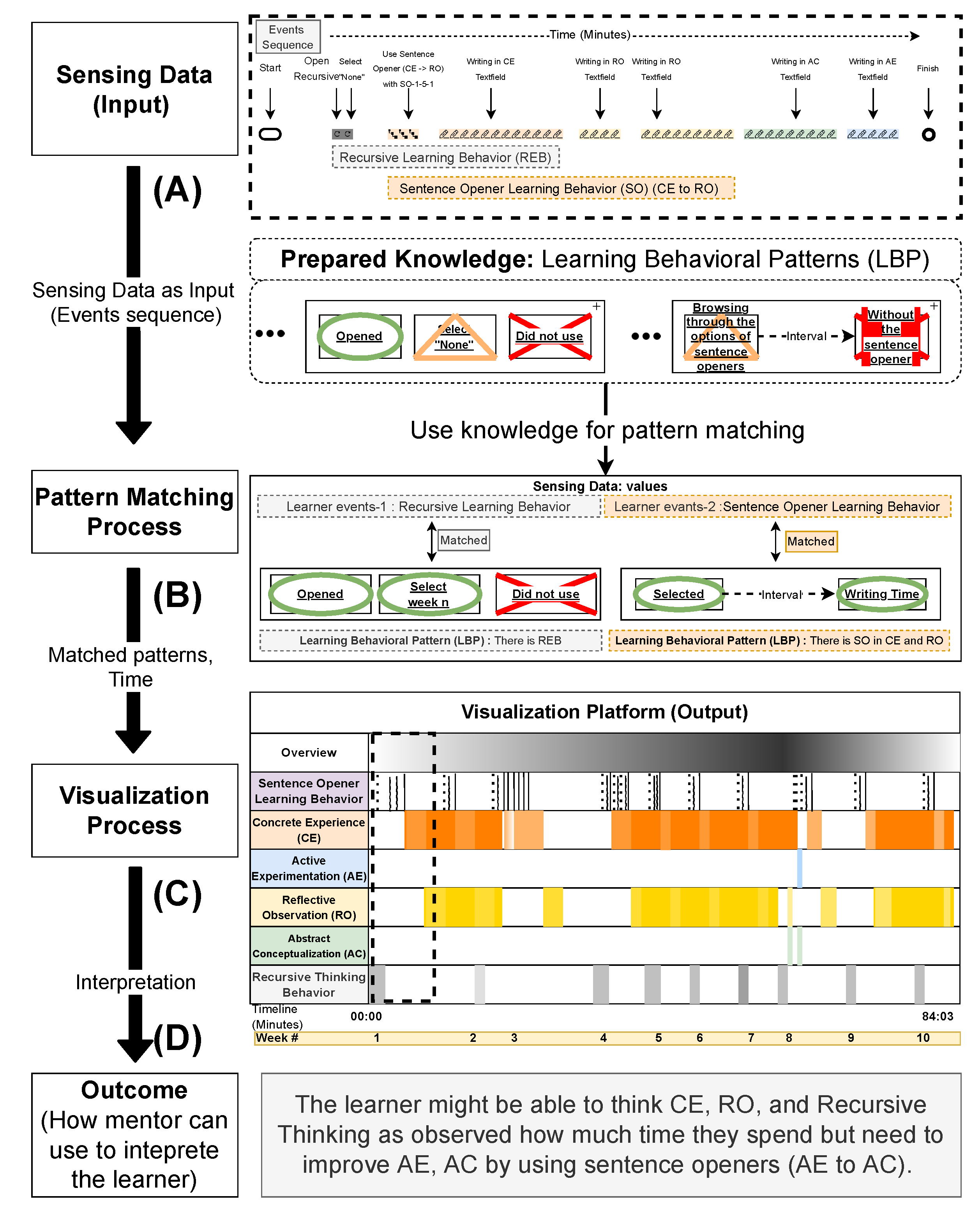

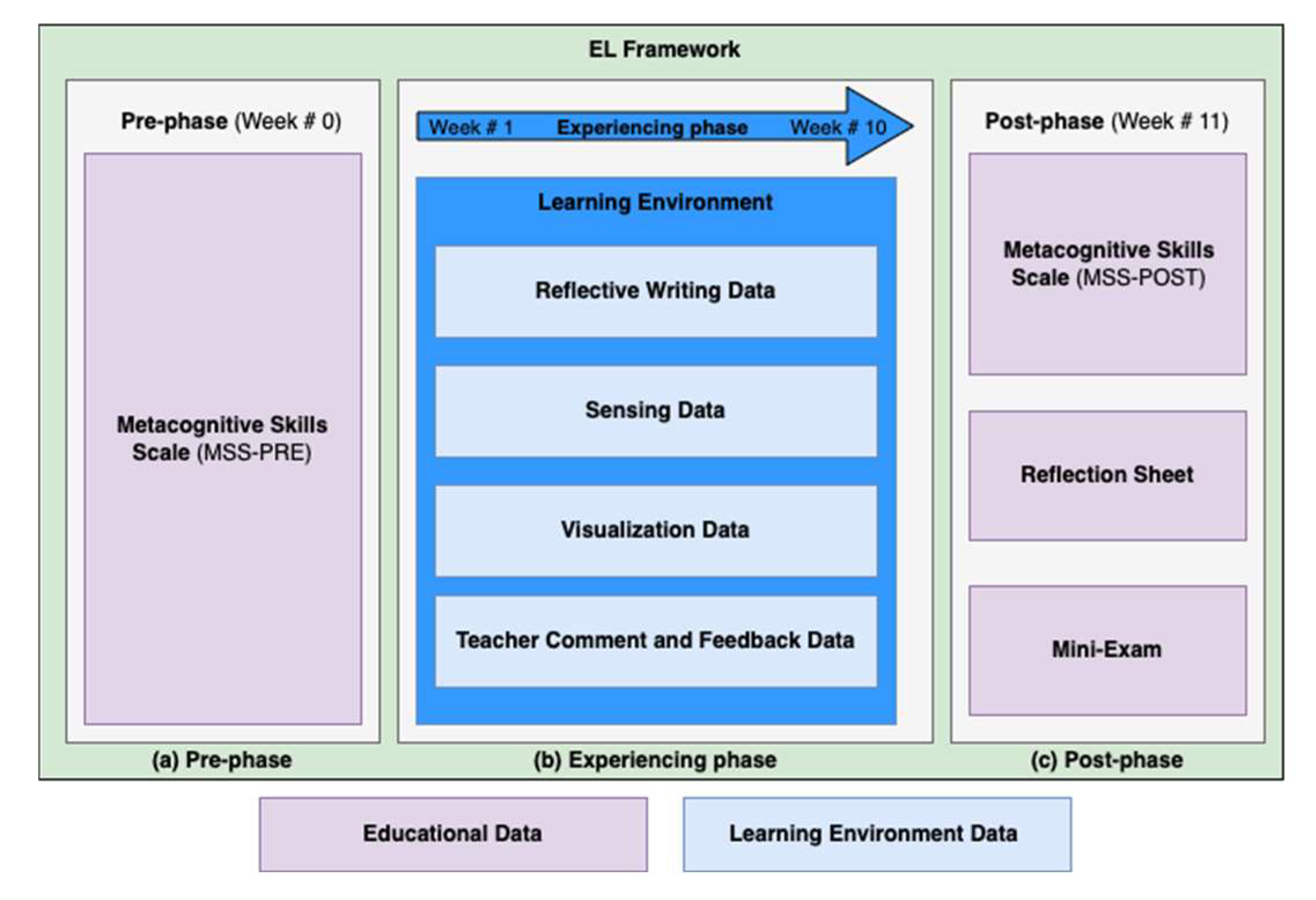
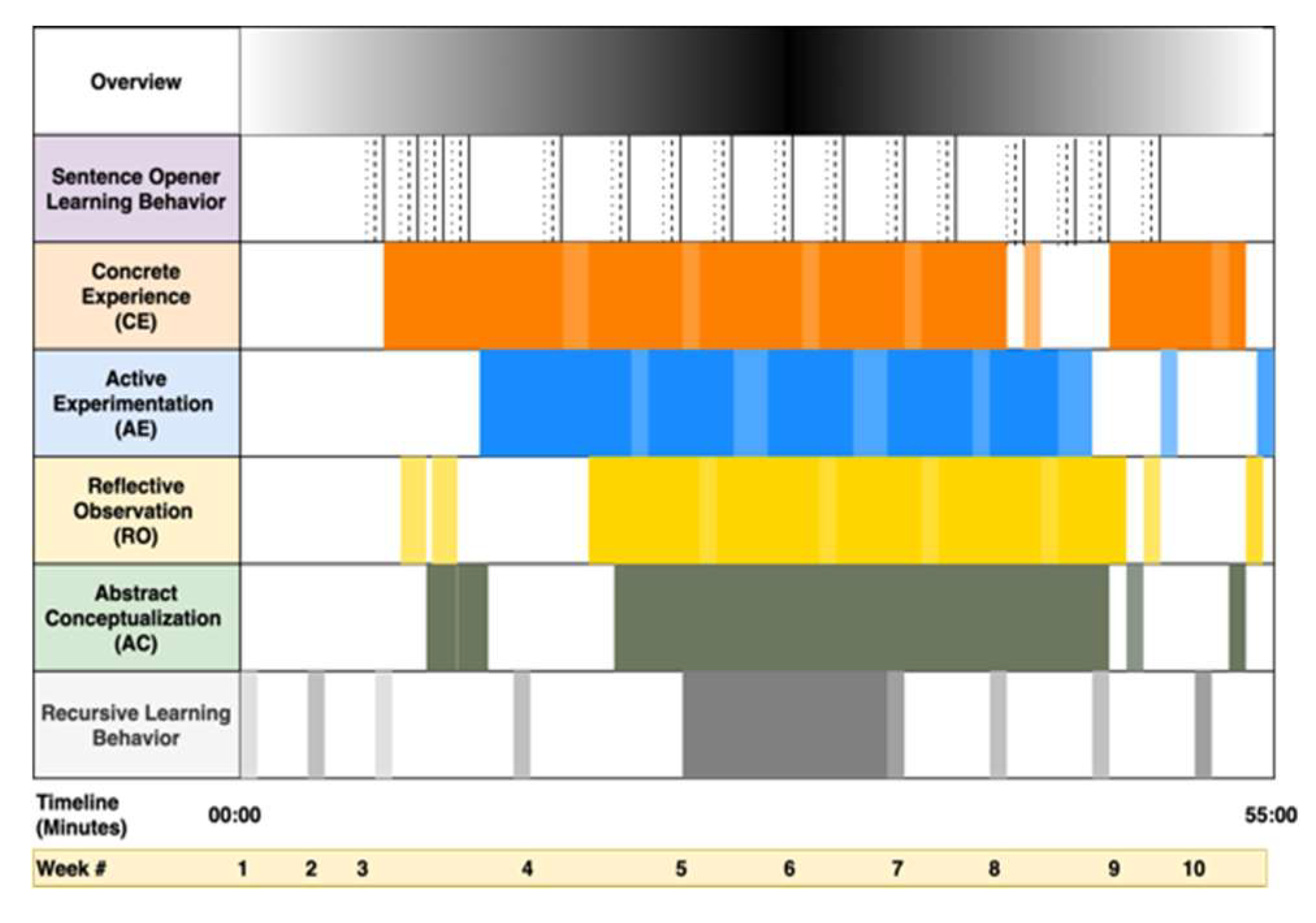

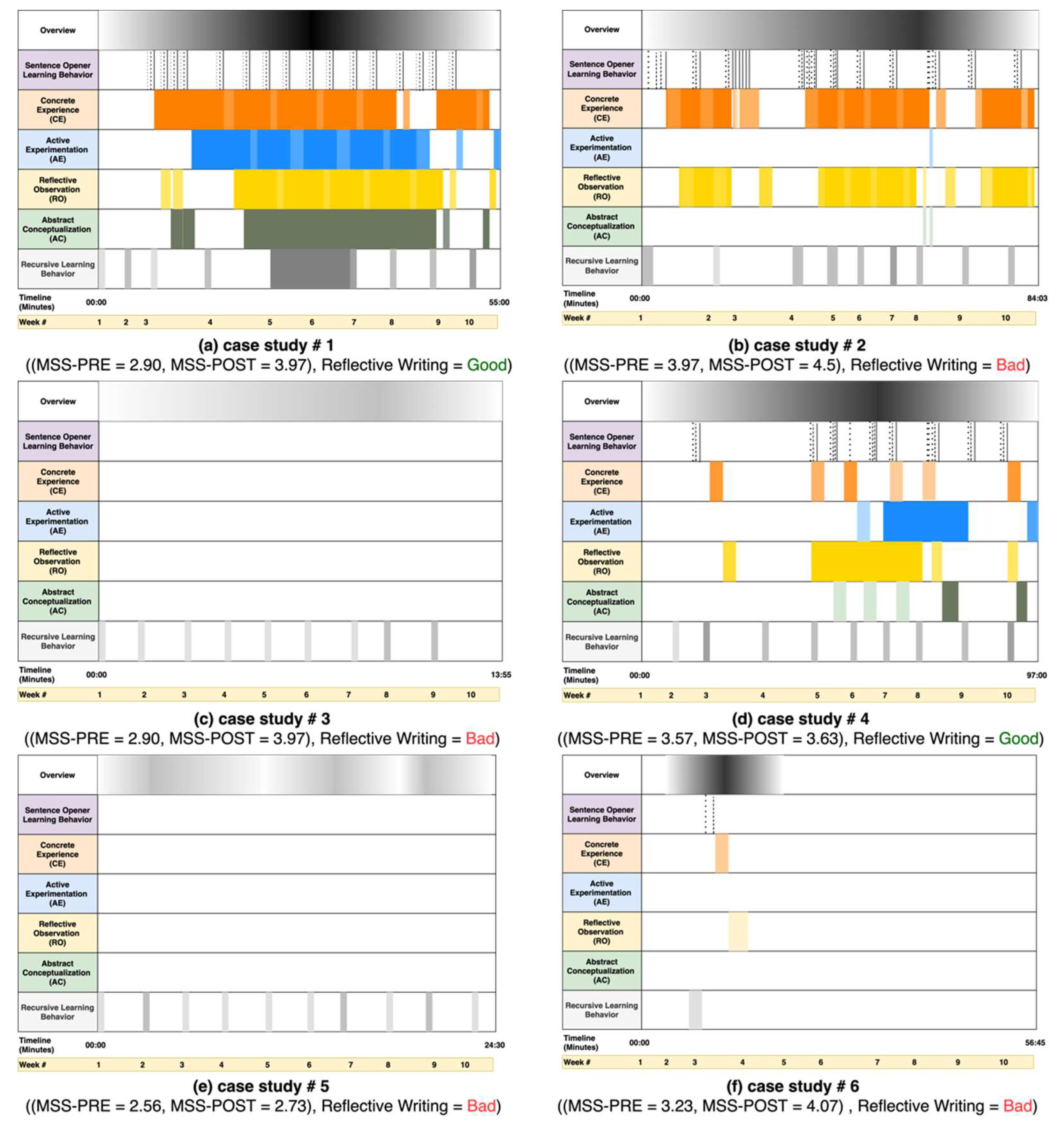
| Example Question in the MSS [33] | Learners’ Reflections (MSS-PRE) | Learners’ Reflections (MSS-POST) |
|---|---|---|
| I use my previous experience while organizing my new learning (Q.03) | I do not care about these questions. I just want to finish them first. But I realize that there is such a thing as using my previous experience to do something. | I am still unsure whether I did something like this in this class, but I guess I can do it well. |
| It is important for me to build meaningful relations between the learned subjects during learning (Q.33) | I am not sure about the meaning behind this item. I think I have never done this before. I will try to apply this skill in the future. | I am still unsure what the meaning of building meaningful relations between what I learn, and my experience is. Then, I guess I can do it. |
| I critically make a plan before beginning to study a text (Q.36) | I sometimes plan before studying a text; I think I should plan more often to improve my learning. | I think I always plan before studying a text but cannot remember it well. So, I guess it is ok to assess myself higher. |
| Concept | Sub-Concept | Example of the Sentence Openers |
|---|---|---|
| CE to RO (Divergent Thinking) | Reflection on a significant experience Reflection on a successful experience Reflection on a failed experience Reflection on a past experience |
|
| RO to AC (Assimilative Thinking) | Learning from the reflection on a failed experience Learning from the reflection on a successful experience Learning from the reflection on a significant experience Drawing a conclusion from an experience |
|
| AC to AE (Convergent Thinking) | Refining knowledge from an experience Continuous improvement Planning to test what I have learned from the experience |
|
| AE to CE (Accommodative Thinking) | Recursive thinking |
|
| Instrument | Variable | Value |
|---|---|---|
| MSS-PRE | Mean | 2.90 |
| MSS-POST | Mean | 3.97 |
| Open-ended questionnaire (pre) | EL definition | Learning and working at the same time to gain more experience. |
| Self-regulated learning strategies in distance learning | I will pay attention to the learning, try not to be stressed, prepare myself to review the coding after I finish each week, check the knowledge, and pay attention to get an A grade. | |
| Attitude toward distance learning | No matter in which situation, I can learn the knowledge. The attention to study is less than in the classroom, so that the understanding is lower. | |
| Mini-exam | EL definition | Reviewing what you have learned in the past, bring the experience back, and apply it in the future |
| Reflection Sheet | Attitude | Before: I find it is boring and do not want to study. After: Be more enthusiastic about studying. |
| Behavior | Before: Lack of purpose and not diligence in studying After: Study harder, be diligent, and review my lessons more. | |
| EL understanding | Before: I think it just a theory that learns to create the experience. After: Thinking and analyzing yourself from your understanding of how you are? What are you doing today? Then understand it or not, how much, why, and what have you learned? What will be used? | |
| EL’s ability | Before: I don’t know anything about how to use it. After: I can apply what I have learned back and apply it in the future. | |
| Reflection on … | CE: Good (4), RO: Good (4), AC: Good (4), AE: Good (4), Recursive thinking: Good (4) | |
| Open-ended questionnaire (post) | Satisfaction | This learning environment changes me: 1. I have set more goals for studying. 2. I have learned that mistakes are what we need to improve ourselves. 3. I have been using my ideas more creatively. |
Disclaimer/Publisher’s Note: The statements, opinions and data contained in all publications are solely those of the individual author(s) and contributor(s) and not of MDPI and/or the editor(s). MDPI and/or the editor(s) disclaim responsibility for any injury to people or property resulting from any ideas, methods, instructions or products referred to in the content. |
© 2023 by the authors. Licensee MDPI, Basel, Switzerland. This article is an open access article distributed under the terms and conditions of the Creative Commons Attribution (CC BY) license (https://creativecommons.org/licenses/by/4.0/).
Share and Cite
Kingkaew, C.; Theeramunkong, T.; Supnithi, T.; Chatpreecha, P.; Morita, K.; Tanaka, K.; Ikeda, M. A Learning Environment to Promote Awareness of the Experiential Learning Processes with Reflective Writing Support. Educ. Sci. 2023, 13, 64. https://doi.org/10.3390/educsci13010064
Kingkaew C, Theeramunkong T, Supnithi T, Chatpreecha P, Morita K, Tanaka K, Ikeda M. A Learning Environment to Promote Awareness of the Experiential Learning Processes with Reflective Writing Support. Education Sciences. 2023; 13(1):64. https://doi.org/10.3390/educsci13010064
Chicago/Turabian StyleKingkaew, Chanakarn, Thanaruk Theeramunkong, Thepchai Supnithi, Pronsiri Chatpreecha, Kai Morita, Koji Tanaka, and Mitsuru Ikeda. 2023. "A Learning Environment to Promote Awareness of the Experiential Learning Processes with Reflective Writing Support" Education Sciences 13, no. 1: 64. https://doi.org/10.3390/educsci13010064
APA StyleKingkaew, C., Theeramunkong, T., Supnithi, T., Chatpreecha, P., Morita, K., Tanaka, K., & Ikeda, M. (2023). A Learning Environment to Promote Awareness of the Experiential Learning Processes with Reflective Writing Support. Education Sciences, 13(1), 64. https://doi.org/10.3390/educsci13010064







